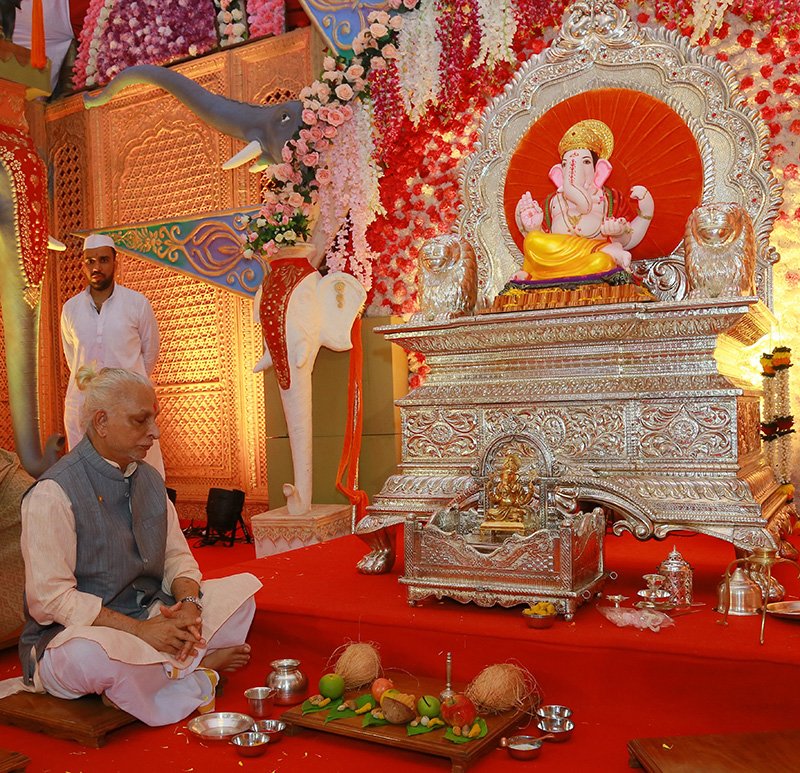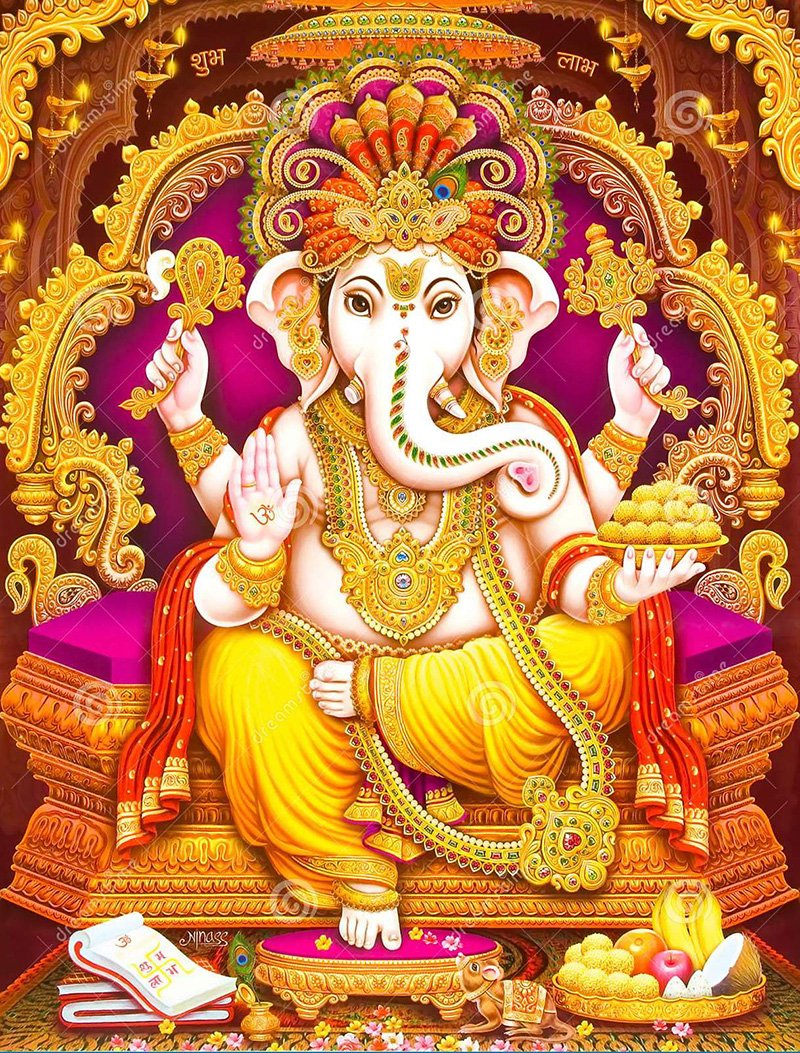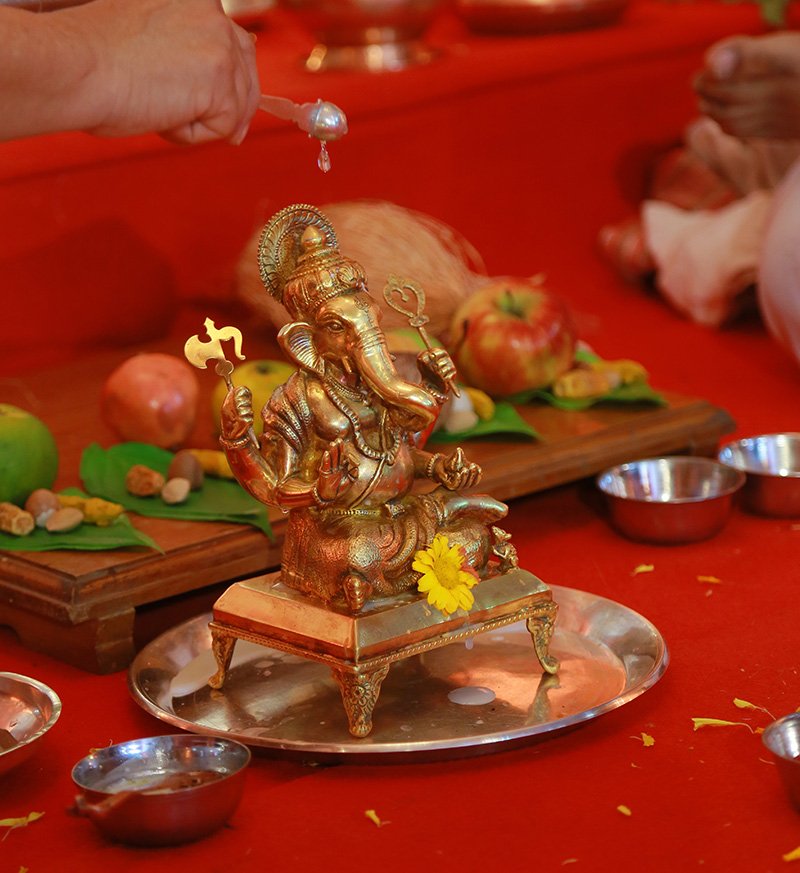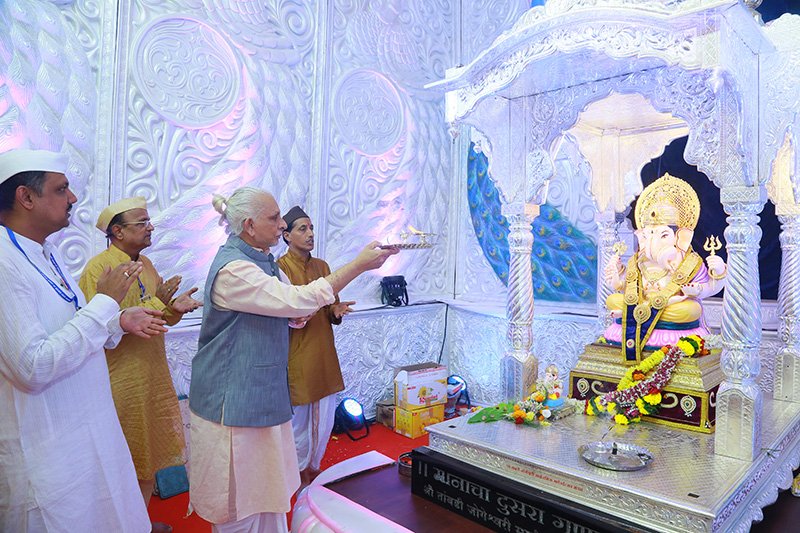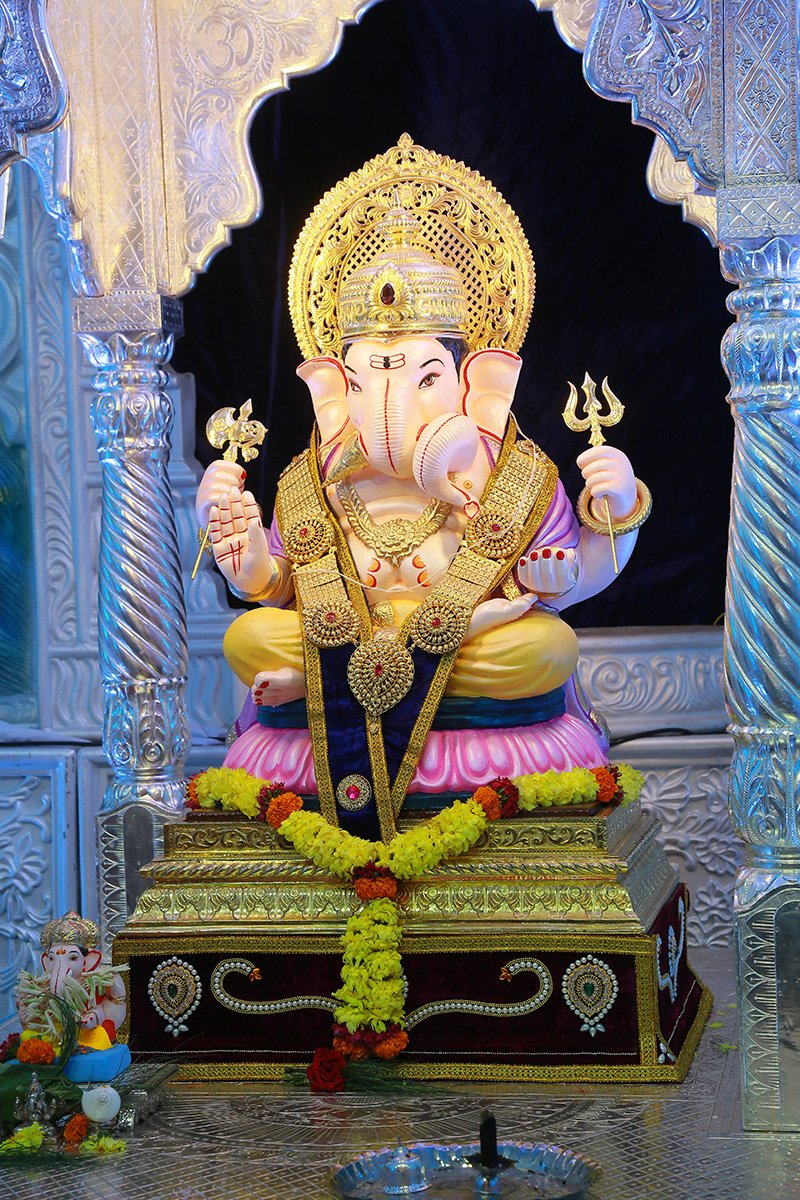In India, we start all our activities by invoking Lord Ganesha, who has a form, shape, and a symbol, but in spite of all the symbols, the scriptures refer to Ganesha in the Ganesha Stavam as :
Ajam nirvikalpam niraakaaramekam
Niraanandam aanandam advaita poornam
Param nirgunam nirvishesham nireeham
Para brahma roopam Ganesham bhajema.
Although we know Ganesha with a form, he is recognized as Ajam nirvikalpam niraakaaramekam; nirvikalpam means without any forms or definitions, without any impurities, you can also say nirmalam, anandam, advaitam and poornam which actually is a description of the Supreme Brahman.
In Para brahma roopam Ganesham bhajema, Ganesha is being symbolized as a manifestation of that Para Brahma which reflects Ekam Sat Vipra Bahuda Vadanti.
So when you bow down to Ganesha, think that you are bowing down to the manifestation of that Para Brahman, the Supreme.
Many symbols and many Gods represent various faces and manifestations of that one single Divine energy. Ganesha is the symbol or the Devta of the Muladhara Chakra. In Yoga and Yoga Tantra, also in Tantra Yoga, apart from the physical organism of the human being, it is said that there is a physio-psychological system of nadis inside the human system. Inside the human organism are the three nadis which are called Ida, Pingala and Sushumna. The lowest end of the Sushumna where both the Ida and Pingala joined together is known as the Muladhara. Muladhara means Moola Adharam, root foundation. That means it is the foundation on which the rest of the human organism is built up. From the Muladhara to the Sahasrara, there are 7 centers of the ascent of consciousness from the grossest level to the subtler level till it reaches the subtlest level. And each therefore represents a level of consciousness which is finer than the other. So the grossest and that which is related to the Earth, therefore represented by the Prakriti tattva is the Muladhara and Muladhara is symbolized by Ganesha with his elephant head.
Therefore Ganesha is the symbol of the root of human consciousness, as it appears on this Earth, the solid Earth, which is called Prakriti, although we have lofty thoughts we are actually centered in this Ganesha on this Earth.
Sex, food, drink, all this is part of the Muladhara Chakras function. And when it is sublimated and activated, the same energy begins to move upward along the Sushumna and reach the Sahasrara chakra, when the yogi experiences what is known as Samadhi. This is the whole process of yoga. And Ganesha has to be invoked first, because the whole thing starts from the Muladhara. So therefore, from the point of view of yoga and tantra, Ganesha is always worshiped in the Muladhara Chakra, internally, and externally. He is represented as sitting in yellow color and a square background. That is the yantra.
Now, all purana says that Ganesha was born from the dirt of Parvati’s body. The dirt that came out of Parvati’s body, again Earth, also implies the Muladhara. He therefore belongs to Prithvi, the solid thing we call Earth and around which our whole consciousness usually dissolves and revolves. Therefore, anything we need to do auspiciously on this Earth, we need to invoke this Ganesha who is a symbol of the very Earth, which we use for our worship, on which we stand, on which we eat. Therefore, Parvati is Shakti. Parvati is a representation of Shakti, who is considered to be the daughter of Himavat. As the Keno Upanishad says, bahu shobhamanam, very beautiful. This is the feminine part of the human organism, which is Shakti, which is also the symbol of Kundalini which lies, three and half times on the Muladhara chakra. Therefore when Ganesha presides over it, it means Shakti and Ganesha are so linked and close to each other because Ganesha was created from the dirt, the skin of Parvati, such a profound symbol. It is actually the beginning of transcendence of consciousness from the gross to the subtle, represented by Ganesha. Then, Elephant – look at the whole body of Ganesha, well fed, placid, and very happy. The head though, is that of an elephant.
There are many puranic stories about this elephant. The head was cut off by Shiva in a fit of anger and was replaced by an elephant’s head and so on. Now, you see, elephants are an ancient symbol of energy, power, greatness, bigness and obedience. In fact, in ancient times, if you owned an elephant, it is like owning a Mercedes now. It was such a symbol of greatness and bigness.
All great people traveled on elephants. Elephants went into battle. To own an elephant was considered to be prestigious and therefore the elephant is represented as a symbol of all bigness, largeness, strength. And in spite of all that, an elephant from the point of view of its own personal life, considers Ahimsa as a Paramo Dharma. It does not kill any animal to fill its stomach. It is a pure vegetarian. It also dispels the myth that a vegetarian cannot be strong.
Ganesha’s head represents strength, infinite potential and greatness, but also gentleness in the form of an elephant.
There is a story in the puranas that Kubera was supposed to be the richest man in the world and who had everything that he thought he had. He was so proud of his wealth that he decided one day to give Ganpati so much food that he would bust his tummy.
So Ganesha was invited, and Kubera offered him food. He finished eating all the food. They had to bring everything they could find from all over the three worlds to feed Ganapati. He happily sat there eating, not looking satisfied until Kubera realized that he was trying to feed the infinite which is impossible to do. That again is another symbol of Ganesha.
There is the symbolism of Ganesha, many people have looked carefully at the picture, especially sideways and seen a resemblance of Om in the trunk and the face. The head and the trunk. If you write in Tamil, from the side it really looks like Ganesha.
Now, the contrast. Ganesha is big, well fed, his head is that of an elephant, his vahana, his vehicle is a small mouse, rat, the rat that usually comes out nocturnally, eats what is under the earth and sits quietly waiting for food. Can you imagine an elephant riding a rat? This is an ancient symbol saying that the highest can be found and carried by the lowest. It is a pointer that if I, as a human being may be small and limited, yet I have the potential to carry the whole Parabrahma and the Universe in my heart. This is the symbol of the rat, the lonely rat moves around especially at night, forages for food in the dustbin and sits as a vahana of a person whose stomach is full and who is always happy with the head of an elephant. This contrast should be particularly noted in the case of Ganesha.
Then, the symbol of Ganesha, as you continue to look at the picture. In one hand, you will find a pasha, noose, and the other holds an ankusha, means a goad, used to poke, to make people do the work. In the elephant’s case, it is used to poke the finger so that it moves. Pasha in one hand and ankusha in the other, Modakam in one hand, and one hand in blessing, all these are profound symbols.
The pasha is the noose with which divinity if it lays its eyes on someone and wants that person to be attracted to itself, throws the noose. Without that noose no one can be pulled towards Divinity. Among the Naths, it is used in the reverse fashion, because Shiva carries the noose also.
So that noose they say is the noose to free us from the noose of the world. But here it is a symbol of drawing you towards that noose, and goad to push you to do good things, even if you are not ready for it.
The modakam is in the hand which the rat is eyeing all the time. Modakam is a sweet, it also means satisfaction, full satisfaction. It is the fruit of wisdom of the understanding of the Brahman. It’s a very sweet symbol; eat it and you are caught; and then you will be taken upwards if you are ready to put your head there. Look closely and you will see that every Ganesha has a third eye, that is a symbol of the Ajna chakra, which is referred to in the seven centers, from Muladhara to Sahasara. The sixth center, between the eyebrows is called the ajna chakra, the eye of wisdom, which when open, one sees beyond with what one can see with one’s’ physical eyes and penetrates into the dimensions of higher wisdom and spiritual oneness.
There is another story in the Puranas. Once, when Shiva and Parvati were trying to figure out who can go around the world fastest, Subramanya who is also their son Kartikeya, got onto his peacock and flew off saying, “let me finish and come before my fat little brother can do anything”. And Ganesha, is supposed to have just gone around Shiva and Parvati three times and came back saying, “I have finished my journey, give me the fruit”. Shiva said, “how?” And Ganesha is said to have replied, “Because you are the whole Universe. Why should I go all around the Universe? If I go around you that is more than enough”. Ganesha, therefore is a symbol of that real aspirant, sincere aspirant who knows that there is no point in going all over the world searching for happiness, you need to just go around the Shivam, Chidananda Roopam Shivoham Shivoham, who sits inside our heart.
He is also called Vinayaka, Vigneshwara, Ganapati.
Ganapati – one meaning is he is the head of all the Ganas, which means the Ganas are those companions of Shiva and they are mostly ghouls from the cremation grounds, because Shiva lives in the cremation ground and Ganapati is appointed as the head of all these Ganas which means he symbolises that energy of the supreme who is in control of all the assistants, the gorkhas who work under him; he is the chief of the gorkha regimen of Shiva.
The other meaning is pati of gananam, calculations, mathematics. That means he is the planner of the Universe.
Vigneshwara is the one who removes all obstacles from you.
If you look closely at the symbol of Ganesha, you would have heard the story that when Vedavyasa wanted to compile the Vedas, he invoked Ganesha. So instead of using an ordinary pen, he broke one tusk and used it as a pen. This is the great symbol, he demonstrates a pen is mightier than the sword, instead of that tusk is mightier than the sword. He uses his tusk as a pen. Now, tusk is usually used for protecting oneself. Instead of that with great self-sacrifice, he breaks his tusk and uses it for vidya, to give knowledge to others.
Ganesha is usually represented as having two Shaktis, two concerts, one is Siddhi and the other is Buddhi. According to the Yoga Sutras of Patanjali, the extraordinary capacities and the powers that a yogi acquires when the connection between his Muladhara and Sahasrara is established are called the Ashta Siddhis. Garima, Laghima, Mahima and so on. Therefore Ganapati is also Ashta Ganapati, because he represents the eight siddhis, which is the sign of a completed yogi, who has reached samadhi. One wife is Siddhi. The other concert is Buddhi, purified intelligence is Buddhi, not mere intelligence. So it again represents the clarity of a spiritual aspirant whose buddhi, intelligence has been completely purified.
These are the symbolic aspects of Ganesha. Therefore, before starting anything, even great sages have always first bowed down to Ganapati. But especially in the South, we have the custom of breaking a coconut, offering it to Ganapati with a prayer – please don’t keep any vignas in front of me, so that I can move forward.
Wish you all a very Happy Ganesh Chaturthi.
-Sri M

